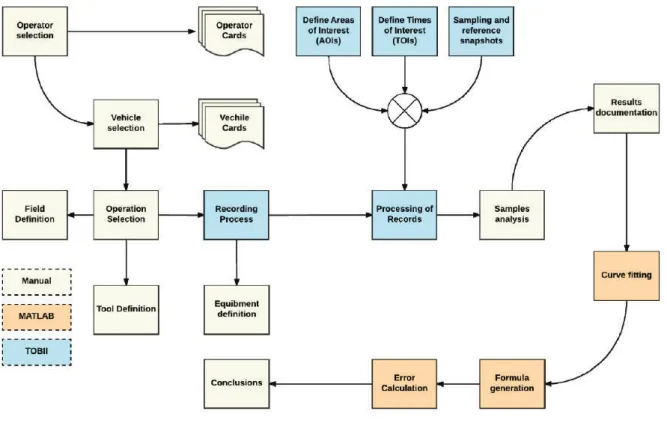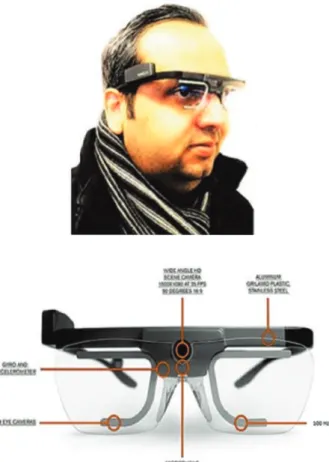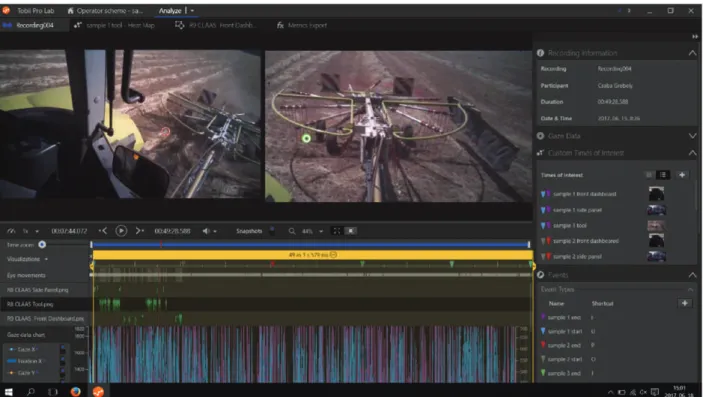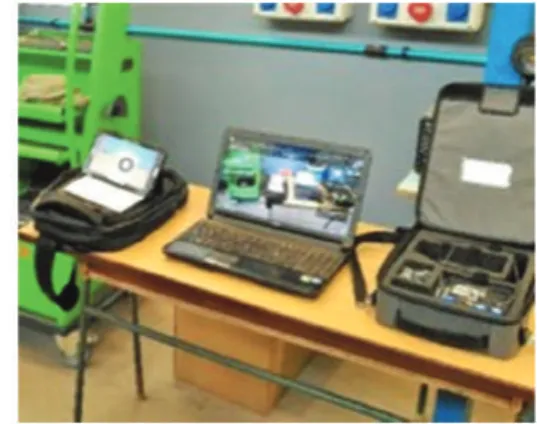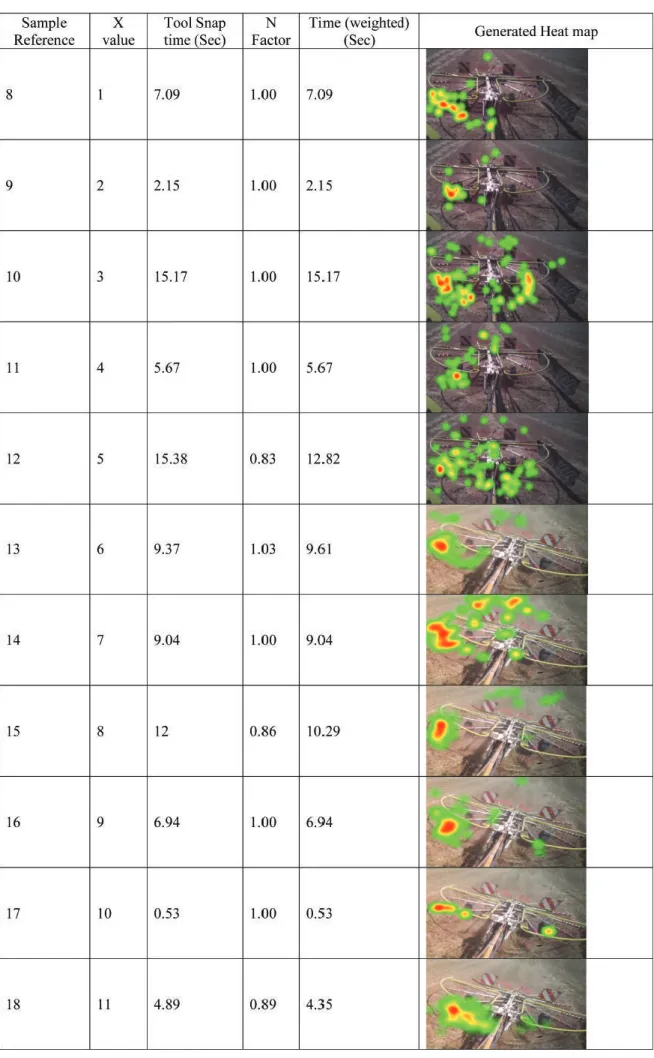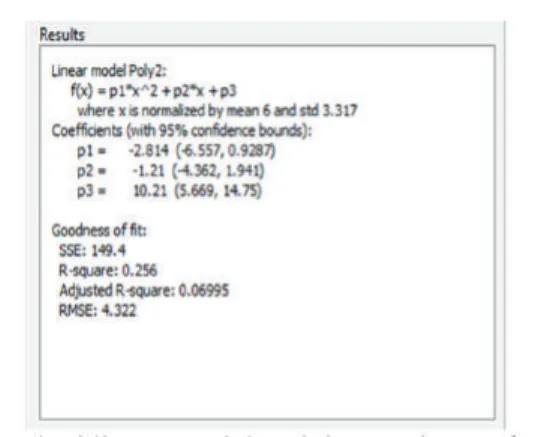Abstract
Operator’s workplace design takes a priority to be developed to increase the level of Quality, Safety and productivity. The multi- tasking vehicles industry design and development process requires dependable and deterministic measures to decide about the tools and equipment in which the new enhancement is ensured to be valuable and reliable using the state-of-the-art engineering solutions. This research is made based on literature of the accumulated knowledge from different studies and analysis are made to provide the necessary input for Human Centred Design process. The results of this research are demonstrating the change on operator’s focusing scheme inside a multi-tasking off-road vehicle along working hours for the attached tool for the multi- tasking vehicle.
Keywords
off-road vehicle, measuring operator’s focusing scheme, eye tracking, lining operation.
1. Introduction
Human-centred-design approach is considered one of the most effective factors enhancing the productivity of vehicles used in the industrial and agricultural fields. The development of operator’s workstation needs to be based on deterministic data which is validated, verified and dependable.
Due to the operational nature of multi-tasking off-road vehicles, operators need to spend long working hours; which increases the level of mental workload leading to human error. ‘Li and Haslegrave [1] introduced similar conclusion of which the vehicle design should be human oriented in order to maximize comfort and ability to perform the driving task perfectly and safely by reducing the human error possibilities’. Nowadays more and more agricultural machines are equipped with continuous measurement sensors e.g. measurement of soil resistance [2] to have more exact information on energy demand. This means that the driver attention is split by many signals.
Operating an off-road vehicle is a complex task, requiring a concurrent execution of various cognitive, physical, sensory and psychomotor skills [3], additionally to control attached tools to perform in-field productive tasks such as agricultural and industrial operations. Ensuring the comfortable ride is considered
essential for any vehicle, as well as executing happily and safely requested operational tasks, to that end; the driver ergonomics comes to play as considered as an important parameter that can’t be neglected in the design phase of the vehicle [4].
Tractors are companions for many agriculture workers. Well- designed human – tractor interfaces, such as well-accommodated tractor operator enclosures can enhance operations productivity, comfort and safety [4-7].
Many studies have been carried on finding preferred locations of in certain types of tractor controls [8], moreover; emphasizing how critical is the placement of controls in some tractors stating that; it actually creates an impediment to body movement [4].
When we are talking about automation, it is a general aim to improve comfort and safety [9-13], additionally, it is stated that, in the automated driving condition, driver responses to the safety critical events were slower, especially when engaged in a non- driving task. At the same time in their paper – dealing with driver visual attention ‘Louw & Merat [14] reached a conclusion shows that the drivers’ understanding of the automated system increases as time progressed, and that scenarios which encourage driver gaze towards the road centre are more likely to increase situation awareness during high levels of automation’.
Generating dependable and deterministic data representing human behaviours inside the workplace using validated method will be beneficial for enhancing current cabin designs as well as the future cabin designs.
This research scope is studying operator’s focusing scheme, which is one of the most beneficial behaviours to be recognized inside the tractor’s cabin using the state of the art engineering solutions to obtain useful results to be considered in the improvement of tractor’s cabin design (i.e. upgrading notification system inside the tractor’s cabin and allocating new equipment or components inside the tractor’s cabin). In addition to enhancing the operation’s work procedures design to increase the productivity of a specific agricultural operation (i.e. break time scheduling).
Driving is not only a physical task but also visual and mental tasks [15]. The eyes of a driver are indispensable in performing visual tasks such as scanning the road, and monitoring in-vehicle devices. Mental tasks are important during driving, and include such factors as understanding vehicle dynamics, making situation-dependent decisions, and judging time/space relationships [16-19] were examined the eye-related measures of drivers’ mental workload. The mental workload could be defined HUNGARIAN AGRICULTURAL ENGINEERING
N° 33/2018 30-37
Published online: http://hae-journals.org/
HU ISSN 0864-7410 (Print) / HU ISSN 2415-9751(Online) DOI: 10.17676/HAE.2018.33.30
THE CHANGE ON OPERATOR’S FOCUSING SCHEME INSIDE A MULTI- TASKING OFF-ROAD VEHICLE ALONG WORKING HOURS
Author(s):
I. Szabó – M. Hushki – Z. Bártfai – L. Kátai Affiliation:
Faculty of Mechanical Engineering, Institute of Mechanics and Machinery, Szent István University, Páter K. u. 1., Gödöllő, H-2103, Hungary
Email address:
szabo.istvan@gek.szie.hu, bartfai.zoltan@gek.szie.hu, mohamma.hushki@hallgato.szie.hu, katai.laszlo@gek.szie.hu PERIODICAL OF THE COMITTEE OF
AGRICULTURAL AND BIOSYSTEM ENGINEERING OF
THE HUNGARIAN ACADEMY OF SCIENCES and
SZENT ISTVÁN UNIVERSITY Faculty of Mechanical Engineering Received: 2017.10.18.; Accepted: 2018.06.29.
as the relation between demands resulted from various tasks to be performed on the operator and his ability to fulfil; with satisfactory; these demands Described those demands as multidimensional, as it involves tasks, operator and system demands together with other factors [20]. Moreover; the studies showed that the need for well fitted architectural space to the operator’s dimensions is considered crucial. Additionally; the mental workload level is found to be increasing with the time passing [21].
For this research, we focus on measuring the focusing scheme of the operator inside the tractor cabin in the lining operation showing by durations the time spent by the operator focusing on selected areas of interest and its change along working hours.
A study conducted in 2015 by Gonçalves and Bengler [22]
claims that Highly Automated Driving (HAD) will be commercially available in a near feature, yet human factors issues like the influence of driver state can have a critical impact in the success of this driving paradigm and in road and field safety. It is
very likely that Driver State Monitoring Systems (DSMS) will play a bigger role than they have played so far.
However, with this new driving paradigm shift is important to select highlight what is transferable from the previous systems.
Due to lack of driving task engagement, driving performance metrics are no longer viable, creating opportunities for other approaches like detecting non-driving task engagement or fatigue countering behaviours. Eye based metrics will remain important.
2. Materials and Methods
To the purpose of this research, the processes is limited to the data extraction and analysis. The followed methodology is summarized in process map showed in (Figure 1) However; the scope is subjected to be extended upon the accomplishment of the all research phases to test new design enhancements and engineering solutions.
Figure 1. Methodology process map Selection of Operators
One operator (Figure 2) is selected to wear the eye-tracking equipment. Operator’s details are listed in the (Table. 1). The operator is mandated to spend several minutes inside the selected vehicle cabin during conducting the lining operation.
Figure 2. Selected operator
Table 1. Operator details
Selection of vehicle
CLAAS tractor (Model: ARES 567 ATZ) is selected to the purpose of accommodating the experimental trials (Figure 3).
This model has a covered workplace for the operator, which is helpful to control some of experimental conditions (i.e.
temperature and humidity) keeping on the consistency of those parameters and conditions.
Figure 3. CLAAS tractor (Model: ARES 567 ATZ) Selection of experimental field
Experimental trials are conducted under the supervision of Szent István University management in a field called by Babat-völgy to the north west of Godollo city (Figure 4).
Figure 4. Babat-völgy field
Figure 5. CLAAS LINER 450T used for hay lining
Selection of operation and attached tool
Lining agricultural operation is selected to be the studied operation in this research. After hay cutting in the agricultural field, lining operations are conducted to sort hay into lines in the field. The operation is conducted by specific tools attached to tractors generating hay lines in order to prepare for the hay baling operation. To the purpose of this research, the used attached tool to the CLAAS tractor (Model: ARES 567 ATZ) is CLAAS LINER 450T (Figure 5).
Tobii Glasses 2 equipment
Tobii Glasses 2 (Figure 6) is used to the purpose of obtaining the operator’s focusing scheme from his real-time gaze analysis to predefined areas of interest. Which is feeding the research results with the main source of data regarding the target behaviour to be studied.
Figure 6. Tobii glasses 2 Controller software
To record eye tracking data, the Tobii Glasses head unit must be fitted onto the test operator’s head (similar to a standard pair of glasses). The system must then be calibrated separately for each participant. In the calibration process the test participant is asked to look at a Calibration Card held in-front of the participant for a few seconds. The researcher then starts the recording from Tobii Glasses Controller Software running on a Windows 8/8.1 Pro tablet or any Windows 8/8.1 or 7 computer. After the session, the researcher stops the recording and removes the head unit from the test participant. All interactions with the eye tracker (adding participants to test, initiating calibration, starting/stopping recordings etc.) are done through Tobii Glasses Controller Software.
The controller software also enables the researcher to view/hear the eye tracking session both in real-time (streamed through a wireless or wired connection) and after the recording. When viewing a recording, you can hear what was recorded on the integrated microphone of the Tobii Glasses 2 Head unit, the participant’s gaze point also appears as a coloured dot on the scene camera video from the HD camera integrated in the Tobii Glasses 2 Head Unit.
Processing of raw data
The main processing tool of the operators’ gazes is the Tobii Pro Lab (Figure 7) which has a powerful post-analysis and visualization tools provide a full spectrum of qualitative and quantitative gaze data analysis and visualizations. Tobii Pro Lab logs events, defines areas of interest, calculates statistics, creates heat maps, and exports data for further analysis in other software.
Figure 7. Tobii pro lab – analyser software Tobii Pro Studio has three different types of fixation filters to
group the raw data into fixations and Tobii Pro Lab uses one type of fixation filter to process the data. These filters are composed of algorithms that calculate whether raw data points belong to the same fixation or not. The basic idea behind these algorithms is that if two gaze points are within a pre-defined minimum distance from each other (Tobii Fixation and ClearView Fixation Filter), or possess a speed below a certain threshold (Tobii I-VT Filter), then they should be allocated to the same fixation. In other words, the user has kept the eyes relatively still between the two sampling points.
MATLAB curve fitting toolbox
Curve Fitting Toolbox™ provides an app and functions for fitting curves and surfaces to data. The toolbox lets you perform exploratory data analysis, preprocess and post-process data, compare candidate models, and remove outliers. The application can be used to conduct regression analysis using the library of linear and nonlinear models provided or specify custom equations. The library provides optimized solver parameters and starting conditions to improve the quality of your fits. The toolbox also supports nonparametric modeling techniques, such as splines, interpolation, and smoothing.
To the purpose of this research, the Curve Fitting Toolbox™
is used to generate the formula represents the change on operator’s focusing scheme inside a multi-tasking off-road vehicle along working hours from the normalized collected data of the operator’s focusing scheme on the attached lining tool CLAAS LINER 450T.
Areas of interest (AOIs) and reference snapshot
The area of interest is a concept and a Pro Lab tool that allows the eye tracking researcher or analyst to calculate quantitative eye movement measures. These include fixation counts and durations.
Using this tool, the researcher simply draws a boundary around a feature or element of the eye tracking stimulus whether it’s a button on a web page or actor walking across a scene in a video clip. Pro Lab then calculates the desired metrics within the boundary over the time interval of interest.
To the purpose of this research, the selected area of interest is the attached tool CLAAS LINER 450T. Reference snapshot is taken for the item in the area of interest form the video recorded by the Tobii Glasses 2 equipment (Figure 8).
Figure 8. Reference snapshot
Sampling
To measure the operator’s focusing on the AOI during the experimental samples of execution times 11 recording samples are used. Each recording sample (X) represents 600 seconds of the real- time recording of the operator’s gaze during the lining operation.
Due to the differences between the planned and actual recoding time, each sample is normalized to represent the 600 seconds of recording with a factor (N) not exceeding the 17% of the planned recording time. However, collected snap times on the attached tool is multiplied by the Normalization factor (N) according to the formula:
Normalized snap time of (X) sample =
Normalization factor (N) * Actual snap time of (X) sample.
Real world mapping and time of interest
Wearable eye tracking devices; such as Tobii Pro Glasses 2;
produce eye gaze data mapped to a coordinate system relative to the wearable eye tracker and the recorded video, not to static objects of interest in the environment around the participant wearing the eye tracker. For most statistical/numerical analysis to be meaningful, the collected eye tracking data needs to be mapped on to items of interest and into a new coordinate system with its origin fixed in the environment around the participant.
To the purpose of this research, automatic real-world mapping tool is used along the time of interest (about 6600 seconds) to measure the operator’s gaze on the selected area of interest in the reference snapshot.
3. Results and Discussion Experimental procedure
An operator is selected to wear the Tobii Glasses 2 equipment which is connected to the central device running Tobii controller software by which the calibration process of operator focusing is conducted and recording process is controlled.
The used tractor (CLAAS Model: ARES 567 ATZ) is located to the operational field (Babat-völgy) attached to the lining tool (CLAAS LINER 450T) conducting the hay lining agricultural operation. The selected area of interested (AOI) is defined to be the attached lining tool.
The operator is mandated to go through the calibration process, start the recording process and get in the tractor cabin for conducting the hay lining operation along 6600 working seconds.
Thereafter; the recording process is stopped. And the recorded video is processed by the Tobii Lab pro software using the automatic real-world mapping tool, which took about 86 working hours. Heat maps representing operator’s focusing scheme during
the recording time are generated by the software, which leads to generate the statistic readings using MS Excel software.
The obtained data is Normalized in accordance to the formula:
Normalized snap time of (X) sample = Normalization factor (N) * Actual snap time of (X) sample. And resulted data is processed using the MATLAB Curve Fitting Toolbox™ to obtain the representing formula for the change on Operator’s focusing scheme inside a multi-tasking off-road vehicle along working hours.
Results
In prior to start recording, the calibration process is done successfully and confirmed automatically by the Tobii controller software and the special calibration card (Figure 9).
Figure 9. Calibration process using the special card and Tobii controller software
Wearing the Tobii Glasses 2 which was connected to the Tobii controller software, after the calibration process, the operator (Mr.
Grebely Csaba) was mandated to proceed conducting his regular tasks in hay lining using the tractor (CLAAS ARES 567 ATZ) and the attached lining tool (CLAAS LINER 450T ) along about 6600 working seconds. Thereafter; the analysis process was started on the recorded video using Tobii Pro Lab software.
After accomplishing the analysis process, the resulted data was exported by the same software to MS Excel sheet. The samples were normalized in accordance to the mentioned normalization formula.
The exported results (Table. 2) showed:
1- The sample reference in the original video (column 1).
2- The sample number (X) (column 2).
3- The tool snap times in (X) sample (column 3).
4- The normalization factor (N) for the sample (X) (column 4).
5- The Normalized tool snap times (X*N) (column 5).
6- The generated heat map for the sample (X) (column 6).
Figure 10. Curve fitting of results
Table 2. Experiment results
Thereafter; the curve fitting operation is conducted using the MATLAB Curve Fitting Toolbox™, the resulted curve (Figure 10) was processed selecting the Linear model (Poly 2) which generates a polynomial equation with the second degree and using Bisquare robust method.
The resulted model and the goodness of fit is shown in (Fig.
11), which gave the final equation:
F(x) = - 2.814 x2- 1.21 x + 10.21
Figure 11. Resulted linear model and the goodness of fit parameters
Discussion
The results showed very accurate and dependable data of the operator’s gaze on selected area of interest. The used equipment and supporting software packages easily defined the time in which the operator paid his attention to the attached lining tool during working time in the lining operation.
The analysis of the recorded sample from lining agricultural operation showed that; clearly; the operator focusing scheme is decreasing along working hours which is related to the increment of physical and mental load as the time of the agricultural operation conducting.
4. Conclusions
The methodology used to generate deterministic results which are validated, verified and dependable to represent the operator’s behaviour of the focusing scheme inside the workplace (tractor cabin).
The variety of filters and options available under the scope of the analyser software capability is found convenient to come over expected challenges during further research activities such as in- field experiments and outdoors activities.
Such generated results confirmed the feasibility of investing the followed methodology in studying more AOIs inside the tractor cabin to feed the design and/or development processes of the tractor cabin with valuable input data beside the conventional user experience feedback and continual research and development channels.
Additionally; the physical load is expected to be reduced by installing a video screen to the dashboard broadcasting live videos of the lining attached tool. And is expected as well to spare the time and physical effort spend on by the operator for checking the parameters of the tractor and the attention planned track direction.
Usability of research results
Increasing the efficiency and effectiveness of any agricultural or industrial operations that involves human operator – workplace
interaction will be the main benefit of implementing this research methodology. Therefore, a limit is expected to be set for having the break time and scheduling the working days or hours based on deterministic data.
Current cabin designs are subjected to be enhanced with interactive guides and/or equipment for operators at the time in when and/or where it is expected to be needed because of the resulted numbers showing a decrement of focusing scheme.
Additionally, this research methodology is expected to be efficient comparison tool between prototypes of new cabin designs, workload of different operations, operating different vehicles etc, based on deterministic measures.
Future research
This research methodology is proposed to be developed for producing deterministic safety related measures to feed operator’s workplace and operation design with the necessary inputs. Which might be dependable to produce the safety or risk assessment reports for certain vehicle or operation design.
References
[1] Li G., Haslegrave C. M.:1999. Seated work postures for manual, visual and combined tasks. Ergonomics, Vol. 42. No. 8.
pp. 1060-1086. http://dx.doi.org/10.1080/001401399185144 [2] Kroulik M., Chyba J., Brant V.: 2015. Measurement of tensile force at the fundamental tillage using tractor’s built-in sensor and external sensor connected between machines and their comparison. Agronomy Research, Vol. 13. No. 1. pp. 95-100.
[3] Young K., Regan M.: 2007. Driver distraction: A review of the literature. In: I.J. Faulks, M. Regan, M. Stevenson, J. Brown, A. Porter & J.D. Irwin (Eds.). Distracted driving. Sydney, NSW:
Australasian College of Road Safety, pp. 379-405.
[4] Hsiao H., Whitestone J., Bradtmiller B., Whisler R., Zwiener J., Lafferty C., Kau T. Y., Gross M.: 2005.
Anthropometric criteria for design of tractor cabs and protection frames. Ergonomics, Vol. 48. pp. 323-53.
http://dx.doi.org/10.1080/00140130512331332891
[5] Matthews, J.: 1977. The ergonomics of tractors. ARC Research Review, Vol. 3. pp. 59-65.
[6] Kaminaka M.S.: 1985. Research needs in the American agricultural equipment industry. Applied Ergonomics, Vol. 16.
No. 3. pp. 217 – 220.
[7] Liljedahl J. B., Turnquist P. K., Amith D. W., Hoki, M.:
1996. Tractors and Their Power Units. pp. 226 – 231 (St. Joseph, MI: American Society of Agricultural Engineers).
[8] Casey S. M., Kiso J. L.: 1990. The acceptability of control locations and related features in agricultural tractor cabs. In Proceedings of the Human Factors Society 34th annual meeting (Santa Monica, CA: Human Factors Society). pp. 743 – 747.
[9] Sheridan T. B.: 1992. Telerobotics, automation, and human supervisory control. MIT Press.
[10] Endsley M. R.: 1996. Automation and situation awareness.
Automation and Human Performance: Theory and Applications, CRC Press. 163–181.
[11] Fukunaga A., Rabideau G., Chien S., Yan D.: 1997.
Towards an application framework for automated planning and scheduling. Aerospace conference. In Proceedings, IEEE.
[12] Scheding S., Dissanayake G., Nebot E. M., Durrant- Whyte, H.: 1999. An experiment in autonomous navigation of an underground mining vehicle. IEEE Transactions on Robotics and Automation, Vol. 15. No. 1. pp. 85–95.
http://dx.doi.org/10.1109/70.744605
[13] Shen S., Neyens D. M.:2017. Assessing drivers' response during automated driver support system failures with non-driving
tasks. Journal of Safety Research, Vol. 61. pp. 149–155.
http://dx.doi.org/10.1016/j.jsr.2017.02.009
[14] Louw T., Merat N.: 2017. Are you in the loop? Using gaze dispersion to understand driver visual attention during vehicle automation. Transportation Research Part C, Vol. 76. pp. 35-50.
http://dx.doi.org/10.1016/j.trc.2017.01.001
[15] Magó L.: 2016. Working hours demand of transportation tasks in foil covered field vegetable production technology.
Hungarian Agricultural Engineering, Vol. 29. pp. 28-31.
http://dx.doi.org/10.17676/HAE.2016.29.28
[16] Kramer A.: 1990. Physiological metrics of mental workload: A review of recent progress. In D. Damos, (Ed.). 2015.
Multiple-task Performance, London, Taylor & Francis. pp. 279- 328.
[17] De Waard D.:1996. The measurement of drivers’ mental workload (Doctoral dissertation). University of Groningen, Haren, Netherlands.
[18] Brookhuis K., De Waard D.: 2010. Monitoring drivers’
mental workload in driving simulators using physiological
measures. Accident Analysis and Prevention, Vol. 42. pp. 898- 903. http://dx.doi.org/10.1016/j.aap.2009.06.001
[19] Marquart G., Cabrall C., Winter J.: 2015: Review of eye- related measures of drivers’ mental workload. Procedia Manufacturing, Vol. 3. pp. 2854 – 2861.
http://dx.doi.org/10.1016/j.promfg.2015.07.783
[20] Sporrong H., Palmerud G., Kadefors R., Herberts, P.:
1998. The effect of light manual precision work on shoulder muscles-an EMG analysis. Journal of Electromyography and Kinesiology, Vol. 8. pp. 177-184.
http://dx.doi.org/10.1016/S1050-6411(97)00032-1
[21] Saxby D. J., Matthews G., Warm J. S., Hitchcock E. M., Neubauer, C.:2013. Active and passive fatigue in simulated driving: discriminating styles of workload regulation and their safety impacts. J. Exp. Psychol. Appl. Vol. 19. No. 4. pp. 287–
300. http://dx.doi.org/10.1037/a0034386
[22] Gonçalves J., Bengler K.: 2015. Driver State Monitoring Systems– Transferable knowledge manual driving to HAD, AHFE.
